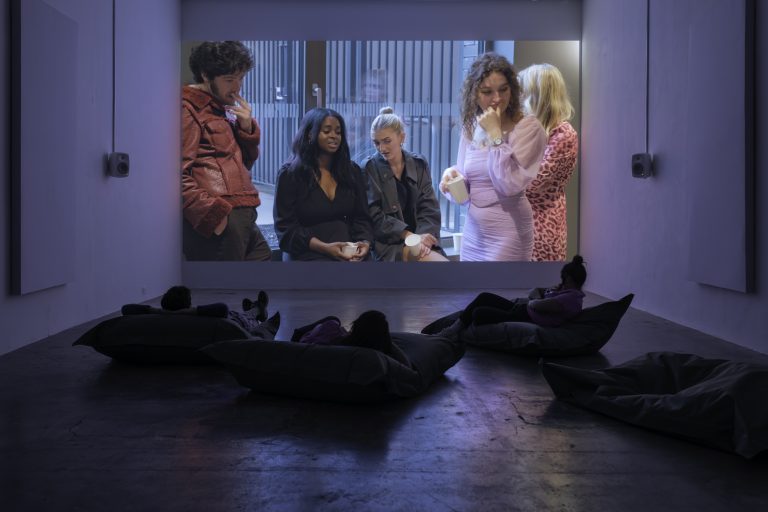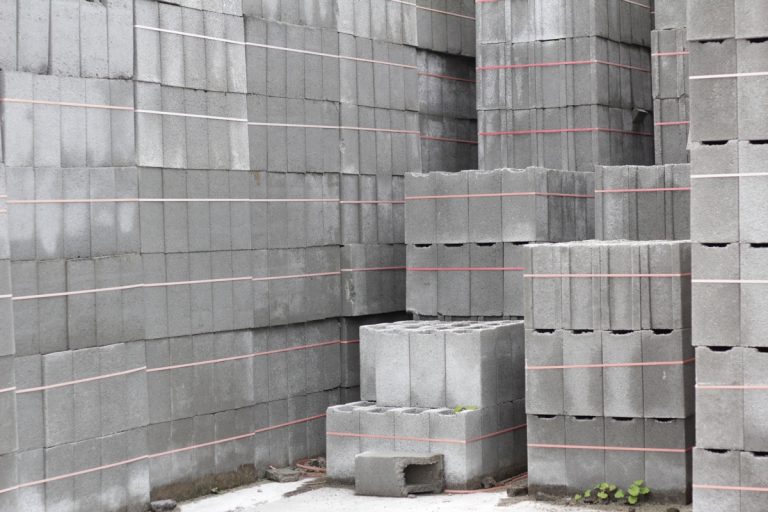In the opening pages of Bad New Days, Hal Foster states that the practice of contemporary art is ‘so vast, so diverse’ that it complicates and frustrates any attempt at constructing a coherent ‘historical overview’. [1] Tracing a period of twenty-five years, he instead deploys a small number of terms or paradigms (abject, archival, mimetic, precarious, and post-critical) that some artworks and art practices have been oriented towards, or can be understood through. Rather than focusing on linear and singular narratives, Foster is concerned with the generation of a constellation of perspectives. Such an approach is typical, and just one example of many that gesture towards the difficulties of approaching the miasmic category of contemporary art with any sense of narrative cohesion.
The eleventh instantiation of Pallas Projects’ Periodical Review is, in certain ways, emblematic of this general tendency, the event itself symbolising a significant milestone for the organisation within the context of institutional contemporary art in Ireland. Not strictly a ‘best of’, the annual exhibition instead positions itself as offering a varied slice of practices whose unicity is founded on their presentness or status as current. So, instead of an explicitly announced thematic fulcrum through which the works might be framed and tethered, Periodical Review instead tacitly summons and aligns itself with a nascent concept of ‘self-organisation’. Herein the facilitation of any second-order curatorial or exhibition-based meaning attributed to individually selected works is off-loaded to a generative process that is to emerge from the relational confluence of the assembled forms.
The works gathered for this occasion of the Periodical Review oscillate over a broad range of conceptual themes and formal designs. Nevertheless, I have chosen to organise this essay around one central idea that has, in various bursts, preoccupied my research for the past number of years, and whose connective current, I believe, can be felt coiling itself around each of the selected works included, as well as the legacy of the Periodical Review as a whole. This is the concept of site, which in this instance refers explicitly to the physical environment of the gallery as an epistemic, legislative, perceptual, and archival technology. More specifically, I am interested in the ways in which aura is identified, housed, exhibited, relocated, and fictionalised within the institutional apparatus of the contemporary art space.
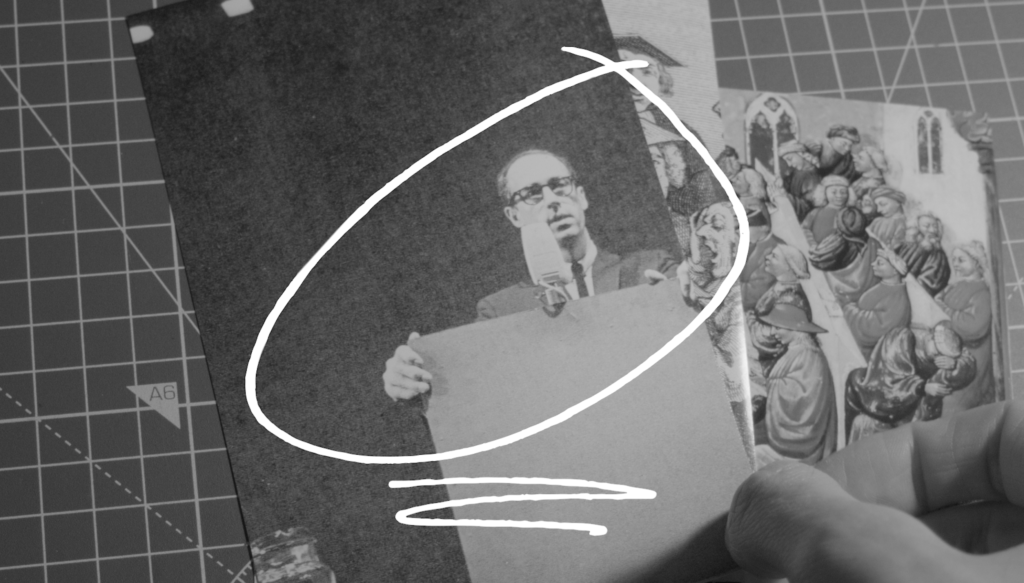
Frank Wasser/The Virtual Lectures
Still from (Lectus – 2021), a work in progress
Courtesy of the artist
As signs of life begin to reappear across the physical terrain of the art world, after more than eighteen months of lockdown protocols, the critical imperative of site has come into focus. The massive structural reconstitution of what defines the concept of space at both private and public scales – and how such environments should be inhabited and navigated – presents an opportunity for questioning and interrogating the borders that define and delimit the physical sites of contemporary art. What are they for? And by what methods do they operationalise the aura of the artwork?
Although now a globalised field, the genealogy of contemporary art, as it is generically understood, still runs through a distinctly Western tradition that emphasises its break with the temporal and conceptual category of European modernism. Even further back, its roots are grounded in ecclesiastical practices derived from the emergence and subsequent cultural domination of Christianity as institution. Remember that some of the earliest examples of de facto Christian art were housed within catacombs – spaces that demanded pilgrimage to a subterranean realm that lay out of sight/site from a political authority above. Catacombs remain intact because they were hidden physical environments, while all other temporary sites devoted to early Christian worship have been eviscerated by the passage of time. And this, in both instances, was the point: the site had to be either invisible or fleeting. The subsequent establishment of the church’s political authority enabled these spaces to become more visible and permanent, yet the residue of the congregational journey into a metaphysical domain persisted. Churches and cathedrals became architectural symbols furnished with reified icons and imagery, providing the model for the modern art gallery as a secular interface, retaining a discrete link to some kind of immaterial aesthetic force or aura.
Aura is a concept with a long and storied history within art and philosophy across the twentieth century. For Walter Benjamin, most infamously, aura had been fundamentally dislocated by the machinic ravages of an industrial modernity that had triggered a virtual annihilation of space (a sentiment that echoes into our own post-digital era). The immolation of such an intrinsic aspect of the artwork rests on its severing from a fixed and discrete spatial location. Therefore, technical reproducibility does not, in and of itself, negate aura; rather it enacts a performative erasure made possible by new media forms that allow for the removal of distance. As Benjamin outlines in a footnote to his 1935 essay ‘The Work of Art in the Age of Mechanical Reproduction’: ‘The definition of the aura as a “unique phenomenon of a distance however close it may be” represents nothing but the formulation of the cult value of the work of art in categories of space and time perception. Distance is the opposite of closeness. The essentially distant object is the unapproachable one. Unapproachability is indeed a major quality of the cult image.’ [2]
The ecstatic acceleration of technologically augmented perception thus allowed aura to be approached from novel, and pragmatically more accessible, perspectives. To paraphrase another passage from Benjamin, the caged world of his own time – previously delimited by the coordinates of a physical environment to which access was conditioned by a variety of unequally distributed factors – had been blown asunder, revealing a series of endlessly expandable experiential plots that become traversable by a new kind of spatial logic. [3] Aura, or at least the historically inflected variant whose legacy is the accretion of cultic ritual, undergoes a phase shift wherein it can longer be enisled within a specific object affixed to a static location. This turning point not only heralds its modification, but also the moment of identification itself. As Boris Groys puts it, aura ‘originates only by virtue of the modern technology of reproduction – that is to say, it emerges in the same moment as it is lost. And it emerges for the same reason for which it is lost’. [4] Accordingly, the modernist fascination with aura is irredeemably bootstrapped to the identification of aura made possible by the paroxysmal confrontation with new formal technologies.
Groys’s own analysis of aura is stimulated by the increasing prevalence of documentation in and as contemporary art; as he emphatically declares, ‘Art […] is no longer present and immediately visible but rather absent and hidden.’ [5] At stake is not simply the liquidation between what constitutes art as distinct from its documentation, but more broadly the cultural and institutional imperatives that facilitate this transition to the aura as a ledger of quantifiable data. Although Groys’s observations are recent, critical interest in the dissolution of reified art into information has a long history.
Art critic Lawrence Alloway outlined a similar position in ‘Network: The Art World Described as a System’ (originally published in a 1972 issue of Artforum), which opens by indexing the various stages the finished artwork passes through. The first exhibition space is typically the artist’s own studio, after which it is placed within another enclosure: the gallery. Subsequent dislocations occur as the work is transported to other galleries, auction houses, private collections, and maybe even a museum archive. In each successive phase, the artwork undergoes a transfiguration, as its relationship to the public and its own status as object is constantly revised. Alloway names a fourth phase as the work is reproduced in catalogues and magazines; in these instances it ceases to be principally a (material) object, now becoming nothing more than information. [6]
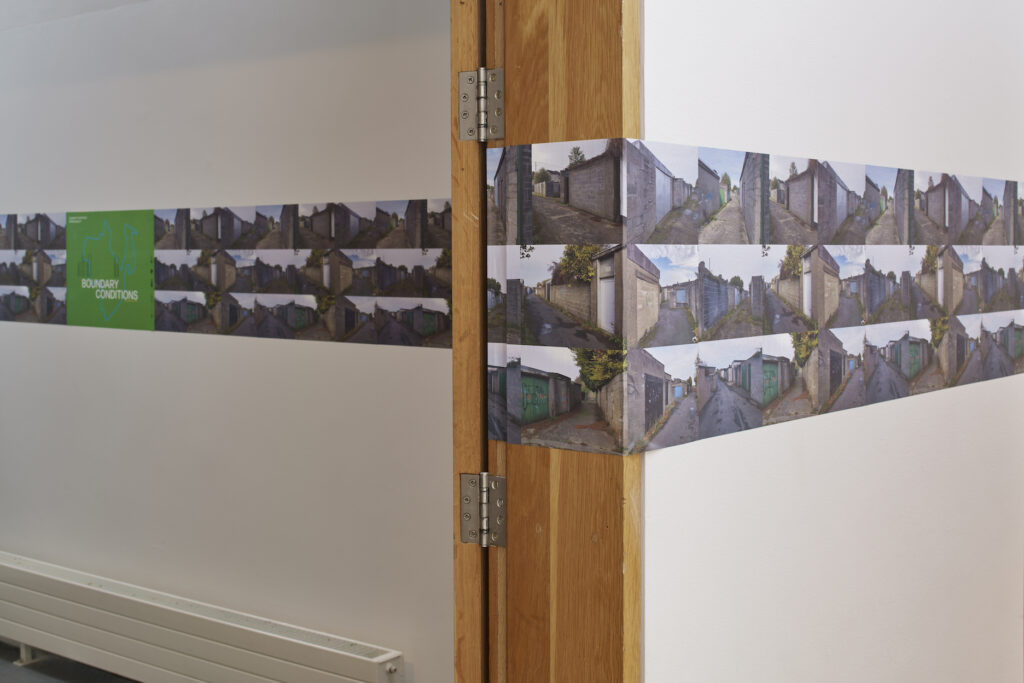
Dennis McNulty
Boundary Conditions, 2021
Posters, paste, geolocated audio collage incorporating sound files both found and recorded by the artist
Photo: Ros Kavanagh
Alloway and Groys both identify the reduction of the artwork to information in a circuit, its multiplicitous aura proliferated through a series of vectors that only seem to signal back towards an originary icon in place. But is this a reduction of aura – its super-flattening as documentation – or simply its redistribution across a network that more accurately mimics its prior existence engulfed within the vitalistic flows of the lifeworld? Previous iterations of the Periodical Review operationalise Michel Foucault’s assertion of the text’s relational status, each book ‘caught up in a system of references to other books, other texts, other sentences’. This quote, from The Archaeology of Knowledge, is directly proceeded, punctuated by a colon, with the rhizomatic claim that: ‘It is a node within a network’. [7] A principle contextual implication herein is that artworks function much the same, entangled within a sea of other works from which they subsequently derive meaning.
I would like to extend this suggestion to propose that if artworks can be said to reside within a network, then their basic unit, understood within an institutional context, is not form, or site, or concept, but rather information. While Alloway would state that the artwork only becomes so in its reproduction as documentation, my claim is that it always-already is such when it is institutionally bound. This is not to say that the artwork is reducible simply to information, as the issue of its aesthetic dimensionality, or its relationship to aura, still remains. Aura is that spasmodic excess that cannot be contained within an object or site, its incarceration within discrete units of information an impossibility. Yet despite this, and keeping within the schemata of signal flow, I think it still may be more useful to think of aura as transmission. This is not just a reiteration that replaces one term with another, but rather a recoding of aura as and into transmission, so that the original concept can be sundered from its ontological reliance on a physical site, instead let roam free across a decentralised field. Aura is of the church, while transmission is of the network.
Such a reordering of the concept of aura helps to better facilitate the various afterlives that the work of art undergoes within a contemporary context. Endless reanimations and dislocations disturb the very idea that there could ever be a fixed Archimedean point from which an artwork can be most objectively and suitably experienced. Glancing at the itinerary of projects selected for this Periodical Review listed on an Excel document, I am met with a gridded arrangement of text fields and hyperlinks that seek to give some kind of tangible structure to the associated practices. I am reminded of Lev Manovich’s claim that the database has replaced linear narrative modes as the principle symbolic form of our modern age. [8] The spreadsheet is, of course, an extreme manifestation of database aesthetics, but it provides a useful map for navigating the eventual exhibition design that will be organised within a physical environment. However, due to the clunkiness of this extremely flattened database field, it is tempting to suggest that my experience of these works is nothing more than an ontologically reduced variant of a phenomena that has been severed from its true setting. My perceptions remain knotted to the thought of an immobile sanctum whose presence is endlessly deferred.
But the more I scan and click, the more that gnawing endorsement is called into question. Some of these works originated off-site in a specific form of non-art locale, while others were birthed directly into cyberspace. As I rewatch Frank Wasser’s Virtual Lectures – whose series of opening questions ends with ‘Where is an exhibition?’ – I am explicitly aware that its access point rests comfortably in between tabs directed towards Netflix, Youtube, and other sectors of the web. I’m walking now with Dennis McNulty’s Boundary Conditions leaking into my eardrums. Perception is emptied from the bodily site in which it is lodged, as cascading reverberations give way to low-frequency croaks that seem to echo from an only partially accessible alien landscape. I can hear the machine hissing in the background, the signal-to-noise ratio enhancing the effect of this variable rate transmission. I wonder: What is a site? Where is a site? Is it actual or is it virtual? How are its conditions established and implemented into the most foundational experiences of reality itself?
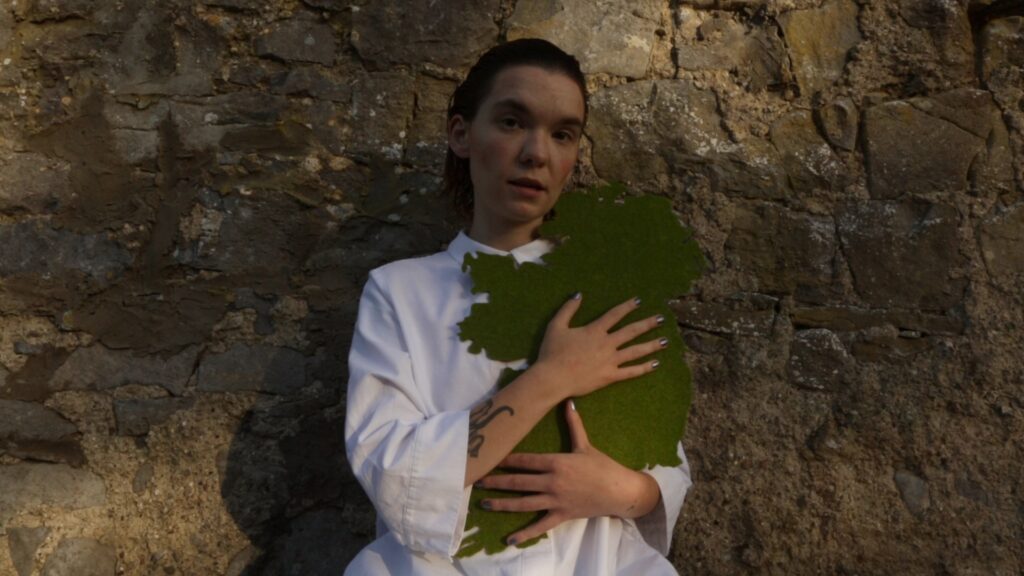
Eimear Walshe
The Land Question: Where the fuck am I supposed to have sex?, 2020
Still from single-channel video
Courtesy of the artist
I will just briefly mention here that such concerns can be felt particularly animated in Eimear Walshe’s The Land Question: Where the fuck am I supposed to have sex? whose performative gambit hinges on the legislative distinction between two kinds of space: public property and private property. This video work, which is presented in the form of an artist talk, brings into play an excavation of place in an Irish context, interrogating the manner by which ownership and access to such has been historically regulated. The sexual act – imagined as that which necessarily precedes any kind of institutional injunctive prohibiting it from certain spaces – can be taken as analogous to the problems of housing and restricting the artwork to specific and fixed institutional enclosures. Redistribution of land is introduced as a possible solution, but one whose enactment has historically sought to fold back in on itself and recapitulate the hard edges between a privileged inside and a neglected outside.
The earliest-known canonical examples of site-specific art sought to leave the institutional apparatus that made the artwork’s form transportable within a precise modulation of environmental contexts posited as neutral and objective. The basic idea was to affix the work to a specific (non-art) location, wherein its status as art is artificially and temporarily removed from the gallery space that would decree its meaning. However, this departure was never really an exit, as the return to the gallery, and its legitimating protocols, was from the outset always-already guaranteed. This is not to say that such endeavours represent a historical failure. The key legacy of such practices lies in their expansion of the borders of the institutional art world itself. Beyond that, the myth of the gallery’s singular and totalising ‘view from nowhere’ was also short-circuited, as the conditions and implications of the environment in which work is situated were brought abruptly into sharp relief.
Within these processes of parallel spatial expansion (art deployed further afield) and compression (art delivered directly to my static body plugged into a network), the function of distance remains integral. [9] We are always at a remove from the auratic slipstream of transmission that infinitely recedes into the inaccessible depths of the aesthetic dimension. While transmission may flow eternal, the work of art is nothing more than a momentary interpolation of that signal, formally animating the inflected coagulants into specific, but temporary, constructions. One moment I am standing in a site; the next I am looking at a photograph of it on a wall. Aesthetic perception runs through both, but the specificities of their manifestation are unique, mediated through particular formal techniques and technologies. Neither method of presentation can sufficiently claim an ontological superiority to the other, as access to the very conditions that ground the work of art as an aesthetic object are only ever offered in fragmentary morsels. Aura as transmission does not decay because it is never entirely present. Its variable rate is ordered across a horizontal plane of experience, rather than a hierarchical totem of decreasing valuation and worth. The maddening regress of aesthetic signals that are briefly captured and entombed within and subsequently made accessible via any site, physical or otherwise, dissipate over time like a fractured mosaic. Transmission once more, and always, returns to disintegration.
Laurence Counihan is an Irish-Filipino writer and critic based in Kerry. He is currently a teaching assistant in the History of Art department at University College Cork.
* This essay was commissioned in collaboration with Pallas Projects/Studios in relation to the eleventh installation of their Periodical Review; further details about the exhibition and ongoing project can be found here. This is the first in a series of texts by early-career critics, to be commissioned annually as part of a collaboration between Paper Visual Art and Pallas Projects/Studios.
Notes
[1] Hal Foster, Bad New Days (New York: Verso, 2015), 1.
[2] Walter Benjamin, ‘The Work of Art in the Age of Mechanical Reproduction’, in Illuminations: Essays and Reflections, ed. Hannah Arendt, trans. Harry Zohn, (repr. New York: Schocken Books, 2007), 243.
[3] Benjamin’s original prose, even in translation, is much more eloquent and effective than my own clumsy appropriation: ‘Our taverns and our metropolitan streets, our offices and furnished rooms, our railroad stations and our factories appeared to have us locked up hopelessly. Then came the film and burst this prison-world asunder by the dynamite of the tenth of a second, so that now, in the midst of its far-flung ruins and debris, we calmly and adventurously go travelling.’ Benjamin, 236.
[4] Boris Groys, ‘Art in the Age of Biopolitics: From Artwork to Art Documentation’, in Art Power (Cambridge, MA: MIT Press, 2008), 60.
[5] Groys, 52.
[6] Alloway states: ‘Each change of milieu will encourage different expectations and readings by a changing audience. A fourth context is literary, the catalogues and magazines in which the work of art is no longer substantially present as an object, but is the subject of information.’ Lawrence Alloway, ‘Network: The Art World Described as a System’, Artforum, September 1972, 28.
[7] Michel Foucault, The Archaeology of Knowledge, trans. A. M. Sheridan Smith (1969; repr. London: Routledge, 2002), 25–26.
[8] See Lev Manovich, ‘Chapter 5: The Forms’, in The Language of New Media (Cambridge, MA: MIT Press, 2001).
[9] This is the tension present within the genealogy of the modernist avant-garde that spirals into our own era of contemporary art – the dialectical positions that, on the one hand, seek to collapse the differential between art and life, while, on the other, engendering a separation that maintains art as distinct from the world and the media-entertainment complex in which it is now firmly enclosed within.


